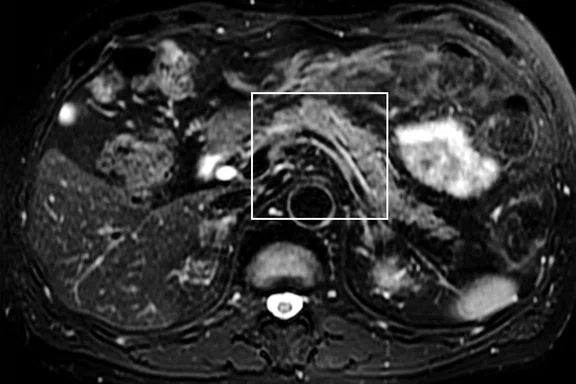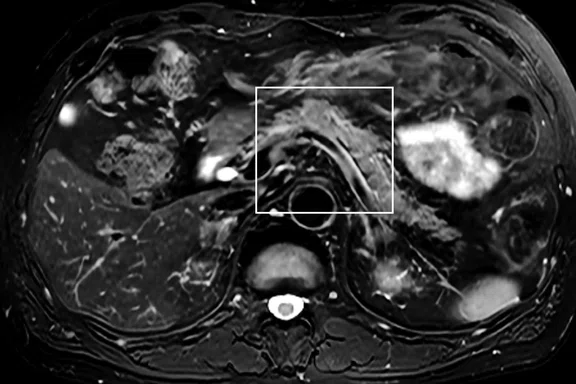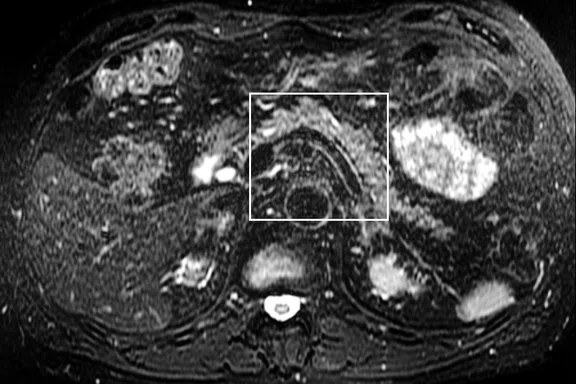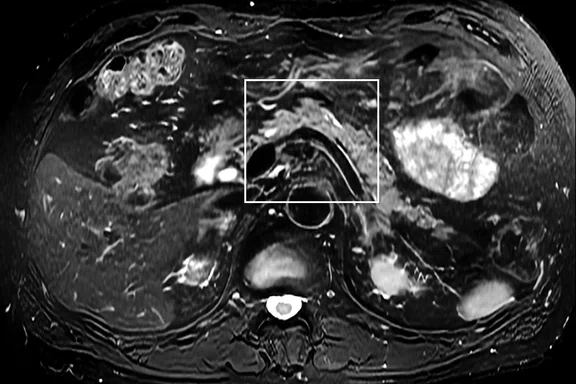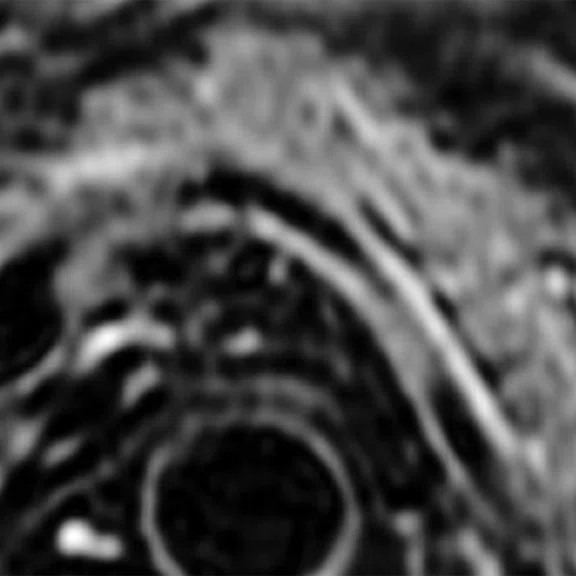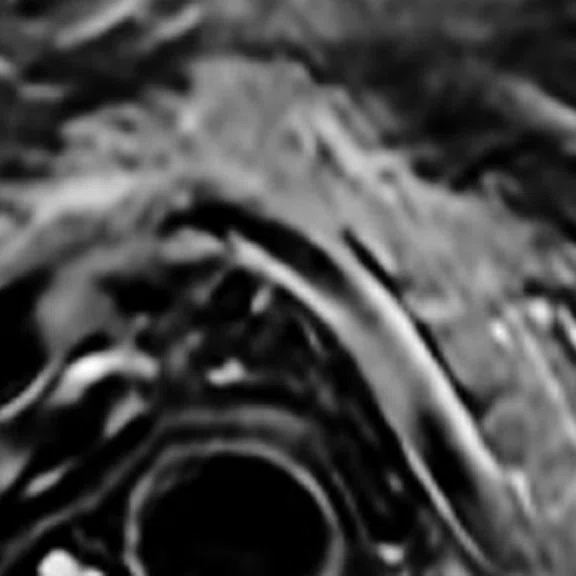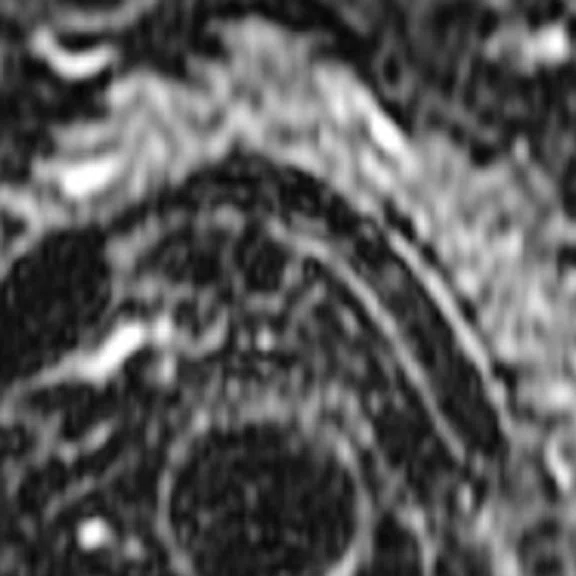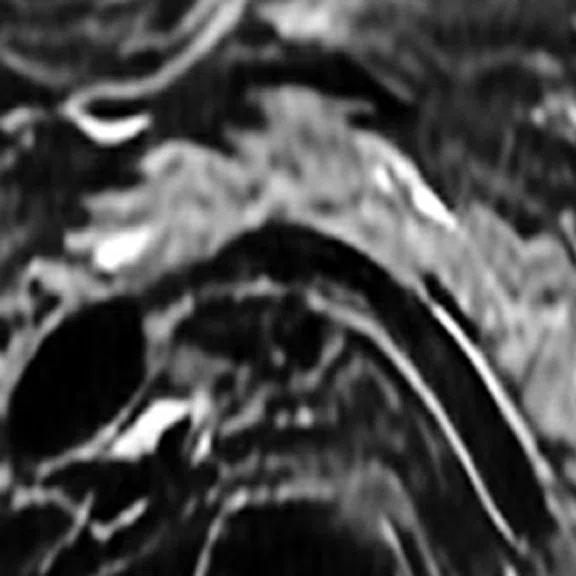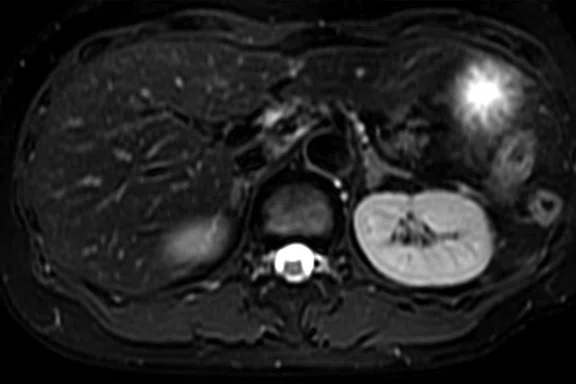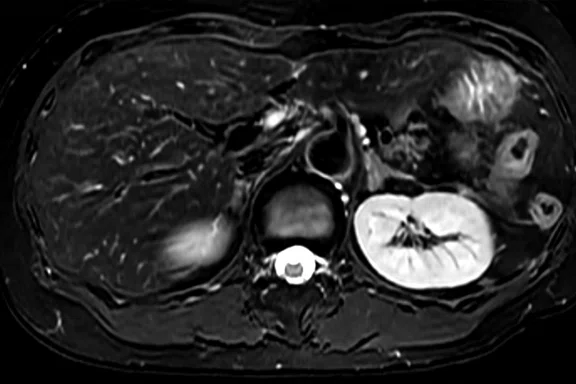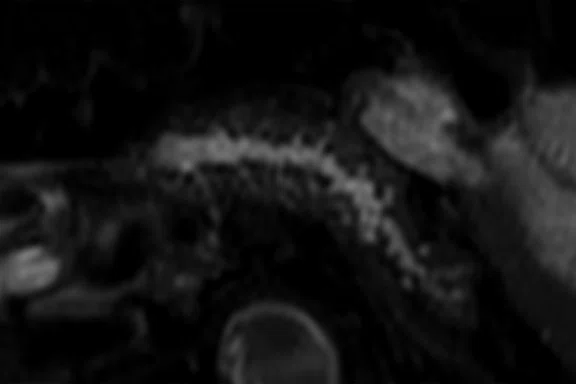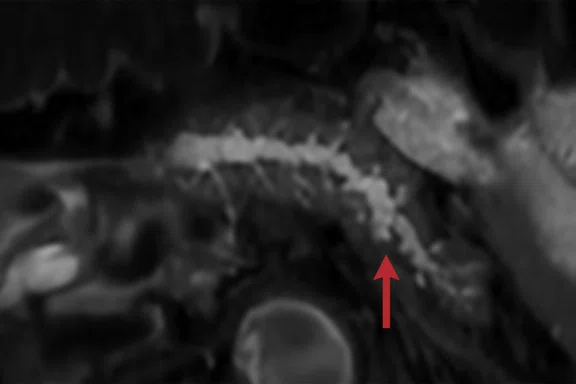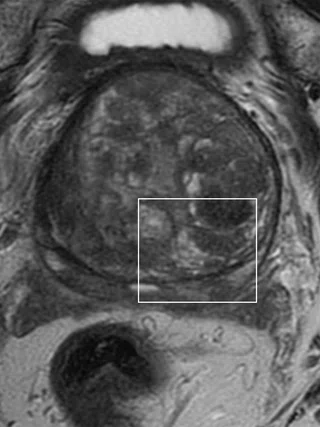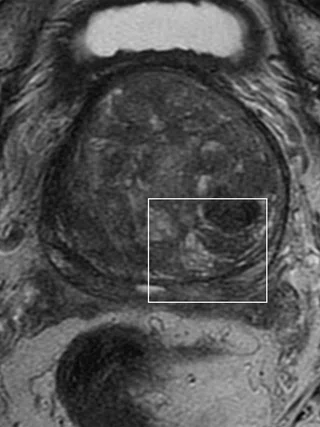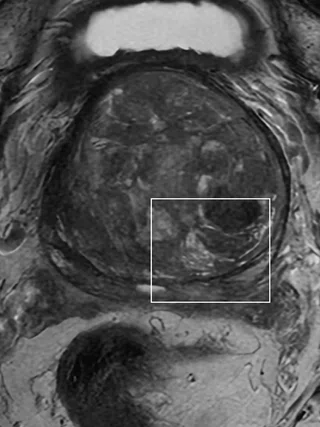A
Figure 2.
AIR™ Recon DL improves spatial resolution and also reduces scan time, in this case by 45 percent. (A) Conventional reconstruction, 1.1 x 1.8 x 5 mm, 2 min. and (B) AIR™ Recon DL, 0.8 x 1.8 x 5 mm, 1:05 min.
B
Figure 2.
AIR™ Recon DL improves spatial resolution and also reduces scan time, in this case by 45 percent. (A) Conventional reconstruction, 1.1 x 1.8 x 5 mm, 2 min. and (B) AIR™ Recon DL, 0.8 x 1.8 x 5 mm, 1:05 min.
A
Figure 3.
AIR™ Recon DL improves visualization of the main pancreatic duct. (A) Conventional reconstruction and (B) AIR™ Recon DL. Images reconstructed from the same raw data.
B
Figure 3.
AIR™ Recon DL improves visualization of the main pancreatic duct. (A) Conventional reconstruction and (B) AIR™ Recon DL. Images reconstructed from the same raw data.
A-1
Figure 4.
AIR™ Recon DL delivers higher SNR and enables the use of low NEX in small FOV imaging. Case of a 77-year-old patient with benign prostatic hyperplasia. (A) NEX value of 5 leads to blurring due to organ motion during the long scan. (B) Lowering the NEX value to 2 removes blurring and reduces scan time, however, images have a low SNR. (C) AIR™ Recon DL enables the use of a low NEX value of 2 with good SNR to improve image quality.
B-1
Figure 4.
AIR™ Recon DL delivers higher SNR and enables the use of low NEX in small FOV imaging. Case of a 77-year-old patient with benign prostatic hyperplasia. (A) NEX value of 5 leads to blurring due to organ motion during the long scan. (B) Lowering the NEX value to 2 removes blurring and reduces scan time, however, images have a low SNR. (C) AIR™ Recon DL enables the use of a low NEX value of 2 with good SNR to improve image quality.
C-1
Figure 4.
AIR™ Recon DL delivers higher SNR and enables the use of low NEX in small FOV imaging. Case of a 77-year-old patient with benign prostatic hyperplasia. (A) NEX value of 5 leads to blurring due to organ motion during the long scan. (B) Lowering the NEX value to 2 removes blurring and reduces scan time, however, images have a low SNR. (C) AIR™ Recon DL enables the use of a low NEX value of 2 with good SNR to improve image quality.
‡Not yet CE marked. Not available for sale in all regions.
A-2
Figure 4.
AIR™ Recon DL delivers higher SNR and enables the use of low NEX in small FOV imaging. Case of a 77-year-old patient with benign prostatic hyperplasia. (A) NEX value of 5 leads to blurring due to organ motion during the long scan. (B) Lowering the NEX value to 2 removes blurring and reduces scan time, however, images have a low SNR. (C) AIR™ Recon DL enables the use of a low NEX value of 2 with good SNR to improve image quality.
B-2
Figure 4.
AIR™ Recon DL delivers higher SNR and enables the use of low NEX in small FOV imaging. Case of a 77-year-old patient with benign prostatic hyperplasia. (A) NEX value of 5 leads to blurring due to organ motion during the long scan. (B) Lowering the NEX value to 2 removes blurring and reduces scan time, however, images have a low SNR. (C) AIR™ Recon DL enables the use of a low NEX value of 2 with good SNR to improve image quality.
C-2
Figure 4.
AIR™ Recon DL delivers higher SNR and enables the use of low NEX in small FOV imaging. Case of a 77-year-old patient with benign prostatic hyperplasia. (A) NEX value of 5 leads to blurring due to organ motion during the long scan. (B) Lowering the NEX value to 2 removes blurring and reduces scan time, however, images have a low SNR. (C) AIR™ Recon DL enables the use of a low NEX value of 2 with good SNR to improve image quality.
A-1
Figure 1.
Improved spatial resolution and slice resolution images are acquired while maintaining SNR. (A,C) Conventional reconstruction and (B, D) AIR™ Recon DL. (A, B) Acquired at 1.1 x 1.8 x 5 mm and (C, D) acquired at 0.8 x 1.8 x 2.5 mm.
B-1
Figure 1.
Improved spatial resolution and slice resolution images are acquired while maintaining SNR. (A,C) Conventional reconstruction and (B, D) AIR™ Recon DL. (A, B) Acquired at 1.1 x 1.8 x 5 mm and (C, D) acquired at 0.8 x 1.8 x 2.5 mm.
C-1
Figure 1.
Improved spatial resolution and slice resolution images are acquired while maintaining SNR. (A,C) Conventional reconstruction and (B, D) AIR™ Recon DL. (A, B) Acquired at 1.1 x 1.8 x 5 mm and (C, D) acquired at 0.8 x 1.8 x 2.5 mm.
D-1
Figure 1.
Improved spatial resolution and slice resolution images are acquired while maintaining SNR. (A,C) Conventional reconstruction and (B, D) AIR™ Recon DL. (A, B) Acquired at 1.1 x 1.8 x 5 mm and (C, D) acquired at 0.8 x 1.8 x 2.5 mm.
A-2
Figure 1.
Improved spatial resolution and slice resolution images are acquired while maintaining SNR. (A,C) Conventional reconstruction and (B, D) AIR™ Recon DL. (A, B) Acquired at 1.1 x 1.8 x 5 mm and (C, D) acquired at 0.8 x 1.8 x 2.5 mm.
B-2
Figure 1.
Improved spatial resolution and slice resolution images are acquired while maintaining SNR. (A,C) Conventional reconstruction and (B, D) AIR™ Recon DL. (A, B) Acquired at 1.1 x 1.8 x 5 mm and (C, D) acquired at 0.8 x 1.8 x 2.5 mm.
C-2
Figure 1.
Improved spatial resolution and slice resolution images are acquired while maintaining SNR. (A,C) Conventional reconstruction and (B, D) AIR™ Recon DL. (A, B) Acquired at 1.1 x 1.8 x 5 mm and (C, D) acquired at 0.8 x 1.8 x 2.5 mm.
D-2
Figure 1.
Improved spatial resolution and slice resolution images are acquired while maintaining SNR. (A,C) Conventional reconstruction and (B, D) AIR™ Recon DL. (A, B) Acquired at 1.1 x 1.8 x 5 mm and (C, D) acquired at 0.8 x 1.8 x 2.5 mm.
A-2
Figure 1.
Improved spatial resolution and slice resolution images are acquired while maintaining SNR. (A,C) Conventional reconstruction and (B, D) AIR™ Recon DL. (A, B) Acquired at 1.1 x 1.8 x 5 mm and (C, D) acquired at 0.8 x 1.8 x 2.5 mm.
B-2
Figure 1.
Improved spatial resolution and slice resolution images are acquired while maintaining SNR. (A,C) Conventional reconstruction and (B, D) AIR™ Recon DL. (A, B) Acquired at 1.1 x 1.8 x 5 mm and (C, D) acquired at 0.8 x 1.8 x 2.5 mm.
A-1
Figure 1.
Improved spatial resolution and slice resolution images are acquired while maintaining SNR. (A,C) Conventional reconstruction and (B, D) AIR™ Recon DL. (A, B) Acquired at 1.1 x 1.8 x 5 mm and (C, D) acquired at 0.8 x 1.8 x 2.5 mm.
B-1
Figure 1.
Improved spatial resolution and slice resolution images are acquired while maintaining SNR. (A,C) Conventional reconstruction and (B, D) AIR™ Recon DL. (A, B) Acquired at 1.1 x 1.8 x 5 mm and (C, D) acquired at 0.8 x 1.8 x 2.5 mm.
C-1
Figure 1.
Improved spatial resolution and slice resolution images are acquired while maintaining SNR. (A,C) Conventional reconstruction and (B, D) AIR™ Recon DL. (A, B) Acquired at 1.1 x 1.8 x 5 mm and (C, D) acquired at 0.8 x 1.8 x 2.5 mm.
D-1
Figure 1.
Improved spatial resolution and slice resolution images are acquired while maintaining SNR. (A,C) Conventional reconstruction and (B, D) AIR™ Recon DL. (A, B) Acquired at 1.1 x 1.8 x 5 mm and (C, D) acquired at 0.8 x 1.8 x 2.5 mm.
C-2
Figure 1.
Improved spatial resolution and slice resolution images are acquired while maintaining SNR. (A,C) Conventional reconstruction and (B, D) AIR™ Recon DL. (A, B) Acquired at 1.1 x 1.8 x 5 mm and (C, D) acquired at 0.8 x 1.8 x 2.5 mm.
D-2
Figure 1.
Improved spatial resolution and slice resolution images are acquired while maintaining SNR. (A,C) Conventional reconstruction and (B, D) AIR™ Recon DL. (A, B) Acquired at 1.1 x 1.8 x 5 mm and (C, D) acquired at 0.8 x 1.8 x 2.5 mm.
result


PREVIOUS
${prev-page}
NEXT
${next-page}
Subscribe Now
Manage Subscription
FOLLOW US
Contact Us • Cookie Preferences • Privacy Policy • California Privacy PolicyDo Not Sell or Share My Personal Information • Terms & Conditions • Security
© 2024 GE HealthCare. GE is a trademark of General Electric Company. Used under trademark license.
IN PRACTICE
Deep-learning-based MR reconstruction designed to address compromise between SNR, scan time and resolution
Deep-learning-based MR reconstruction designed to address compromise between SNR, scan time and resolution
There is an inherent compromise in MR between image quality and scan time. Higher image quality, achieved through higher SNR and/or spatial resolution needed to show anatomical detail, necessitates long scan times, whereas faster scans compromise image quality and diagnostic confidence. The University of Yamanashi Hospital evaluated a prototype version of AIR™ Recon DL‡ and reported shorter scan times and higher resolution across 80 patient cases.
There is an inherent compromise in MR between image quality and scan time. Higher image quality, achieved through higher SNR and/or spatial resolution needed to show anatomical detail, necessitates long scan times, whereas faster scans compromise image quality and diagnostic confidence. The University of Yamanashi Hospital evaluated a prototype version of AIR™ Recon DL‡ and reported shorter scan times and higher resolution across 80 patient cases.
AIR™ Recon DL is a pioneering, deep learning-based reconstruction software designed to improve SNR and image sharpness, enabling shorter scan times. It improves image quality at the early reconstruction level by removing image noise and ringing artifacts, making use of the raw image data. It uses a neural network trained on over 10,000 images to recognize patterns characteristic of noise and low resolution to reconstruct only the ideal image. The result is TrueFidelity™ MR images for clinical excellence without conventional compromises.
Utaroh Motosugi, MD, PhD, an Associate Professor in the Department of Radiology at University of Yamanashi Hospital, one of the first clinical sites to evaluate a prototype version of AIR™ Recon DL, believes it’s a solution that could offer a considerable clinical impact.
Located in the central valley city of Yamanashi in the shadow of Mount Fuji, the hospital installed the AIR™ Recon DL prototype on their Discovery™ MR750 in March 2019 to explore high-quality upper body scans and scan time. Since then, the facility has used the software for approximately 80 cases.
He notes the facility applied a higher frequency matrix to deliver higher resolution, but maintained the same phase matrix to preserve scan time. Dr. Motosugi believes that AIR™ Recon DL can enable a 36 percent smaller voxel size without impacting SNR.
Dr. Motosugi adds that a 2D thin slice (0 mm gap) MPR can provide a better image with AIR™ Recon DL than a 3D scan without AIR™ Recon DL. "We can clearly see SNR improvement with AIR™ Recon DL," he continues. "It can be used for both scan time reduction and higher spatial resolution."
"Compared to clinical routine protocols, AIR™ Recon DL provides much better SNR due to the noise-reduction performance. Now we can visualize quite small anatomy in detail with less blurring."
Dr. Utaroh Motosugi
AIR™ Recon DL, according to Dr. Motosugi, may also reduce the number of excitations (NEX) as a means of reducing scan times.
With respect to lesion detection, Dr. Motosugi explains, "AIR™ Recon DL provides better diagnostic confidence by helping the clinician differentiate between normal structures and lesions, helping clinicians better understand the relationship between them."
Due to its small size and location in the body, the pancreas requires thinner slices and higher SNR to capture clear images. With AIR™ Recon DL, Dr. Motosugi uses a thin slice 2D T2-weighted acquisition to solve this challenge and visualize the relationship between cysts and the pancreatic duct location.
A-2
B-2
C-2
Figure 4.
AIR™ Recon DL delivers higher SNR and enables the use of low NEX in small FOV imaging. Case of a 77-year-old patient with benign prostatic hyperplasia. (A) NEX value of 5 leads to blurring due to organ motion during the long scan. (B) Lowering the NEX value to 2 removes blurring and reduces scan time, however, images have a low SNR. (C) AIR™ Recon DL enables the use of a low NEX value of 2 with good SNR to improve image quality.
Lesions on the adrenal gland can be difficult to image due to the organ’s small size, but with AIR™ Recon DL, Dr. Motosugi hopes to overcome these challenges.
Prostate imaging is particularly impressive. "We’ve found that small nodules due to prostate cancer can be clearly visualized with AIR™ Recon DL," he said. "It’s very important to see detailed structures inside the prostate because sometimes small cancers can be hidden by surrounding structures, and AIR™ Recon DL helps with this."
He previously used a higher NEX factor for high-resolution imaging of the prostate, which added scan time and often introduced respiratory motion artifacts into the images. "AIR™ Recon DL allows us to scan the prostate with higher resolution, shorter scan times, lower NEX and less blurring artifact without compromising SNR."
Dr. Motosugi’s goal is to continue using AIR™ Recon DL to further reduce scan times and address motion artifacts in routine scans.
"We found clear image quality improvement and high resolution imaging coming from the SNR improvement so far. In the future, we will try to get both better image quality and shorter scan times with AIR™ Recon DL."
Dr. Utaroh Motosugi
He does not believe there will be a "technology barrier" to combine AIR™ Recon DL with other applications and pulse sequences in the future.











